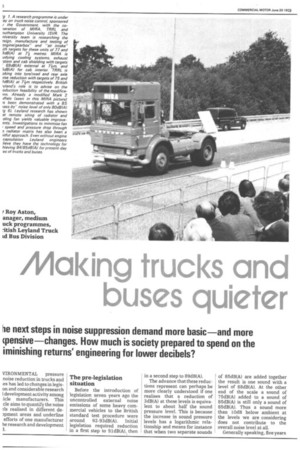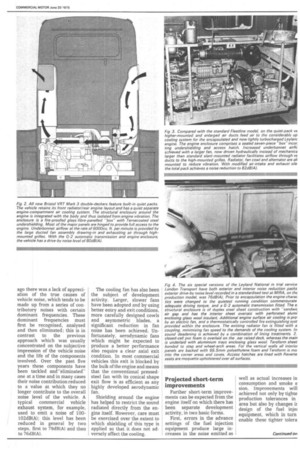Making trucks and buses quieter
Page 78

Page 79

If you've noticed an error in this article please click here to report it so we can fix it.
VIRONMENTAL pressure noise reduction in trucks and .es has led to changes in legison and considerable research [ development activity among icle manufacturers. This cle aims to quantify the noise 31s realised in different de)pment areas and underline efforts of one manufacturer he research and development 1.
The pre-legislation situation
Before the introduction of legislation seven years ago the uncontrolled external noise emissions of some heavy commercial vehicles to the British standard test procedure were around 92-93dB(A). Initial legislation required reduction in a first step to 9 1 dB(A), then in a second step to 89dB(A), The advance that these reductions represent can perhaps be more clearly understood if one realises that a reduction of 3dB(A) at these levels is equivalent to about half the sound pressure level. This is because the increase in sound pressure levels has a logarithmic relationship and means for instance that when two separate sounds of 85dB(A) are added together the result is one sound with a level of 88dB(A). At the other end of the scale a sound of 75dB(A) added to a sound of 85dB(A) is still only a sound of 85dB(A). Thus a sound more than 10dB below ambient at the levels we are considering does not contribute to the overall noise level at all, Generally speaking, five years ago there was a lack of appreciation of the true causes of vehicle noise, which tends to be made up from a series of contributory noises with certain dominant frequencies. These dominant frequencies must first be recognised, analysed and then eliminated; this is in contrast to the previous approach which was usually concentrated on the subjective impression of the vehicle noise and the life of the components involved. Over the past five years these components have been tackled and' eliminated" one at a time and in many cases their noise contribution reduced to a value at which they no longer contribute to the overall noise level of the vehicle. A typical commercial vehicle exhaust system, for example, used to emit a noise of 100102(113(A); this level has been reduced in general by two steps, first to 79c113(A) and then to 76d13(M. The cooling fan has also been the subject of development activity. Larger, slower fans have been adopted and by using better entry and exit conditions, more carefully designed cowls and asymmetric blades, a significant reduction in fan noise has been achieved. Unfortunately, aerodynamic fans which might be expected to produce a better performance also require a clear axial exit condition. In most commercial vehicles this exit is blocked by the bulk of the engine and means that the conventional pressedsteel fan with its conical shape exit flow is as efficient as any highly developed aerodynamic fan.
Shielding around the engine has helped to restrict the sound radiated directly from the engine itself. However, care must be exercised over the extent to which shielding of this type is applied so that it does not adversely affect the cooling. Fig 4. The six special versions of the Leyland National in trial service London Transport have both exterior and interior noise reduction packs exterior drive-by noise_level recorded in a standardised test at MIRA, on the production model, was 76dB(A). Prior to encapsulation the engine charac tics were changed to the quietest running condition commensurate adequate driving torque, and a G-2 automatic transmission fitted. The e structural enclosure is of duplex steel sheet construction with "sandwit air gap and has the interior sheet overlaid with perforated alumi enclosing glass wool insulartt. Additional engine surface air cooling is pro' by an electric fan, and a thermostatically controlled fire extinguishing syst provided within the enclosure. The existing radiator fan is fitted with a coupling, minimising fan speed to the demands of the cooling system. In sound deadening is achieved by a combination of lining treatments. 2. closed-cell pvc foam is overlaid on the . ear raised deck, whereas the main is underlaid with aluminium trays enclosing glass wool. Teroform sheet bonded to step and wheel-arch areas. For the vertical walls all interior panels are backed with 66.5mm polyethylene foam and Tero form is ma into the corner areas and coves. Access hatches are lined with Reverie. seats are moquette upholstered over all surfaces.




























































































































































